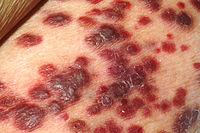
Photo from wikipedia
Efficient delivery of vaccines to dendritic cells (DCs) is critical for inducing sufficient immune response and realizing effective cancer immunotherapy. In the past decade, researchers have spent tremendous effort in… Click to show full abstract
Efficient delivery of vaccines to dendritic cells (DCs) is critical for inducing sufficient immune response and realizing effective cancer immunotherapy. In the past decade, researchers have spent tremendous effort in delivering vaccines by using nanoparticles. However, most of the present strategies are designed based on receptor-mediated endocytosis to increase nanovaccines uptake by DCs, and underestimate the role of macropinocytosis in taking up exogenous antigen. Here, we proposed that macropinocytosis, an efficient pathway for DCs to internalize extracellular fluid-phase solutes, might be utilized as a highly-effective approach to facilitate nanovaccines uptake in DCs. Accordingly, we designed a biomimetic nanovaccine (R837-αOVA-ApoE3-HNP), composing of a poly-(D, l-lactide-co-glycolide) (PLGA) core to encapsulate adjuvant imiquimod (R837), a phospholipid membrane to load antigen peptide (αOVA), and apolipoprotein E3 (ApoE3), to boost the internalization of antigens into DCs. The nanovaccine exhibited highly efficient cellular uptake into DCs through the macropinocytosis pathway, and significantly promoted DCs maturation and antigen presentation. After subcutaneous injection, the nanovaccine was efficiently drained to lymph nodes. Strong T cell immune responses including the generation of antigen-specific CD8+ T cells, expansion of IFN-γ+ CD8+ T cells and the secretion of IFN-γ+ were observed after the vaccination of R837-αOVA-ApoE3-HNP. It also efficiently inhibited the formation of tumor metastasis in lung as a prevention vaccine, and exerted superior therapeutic efficiency on B16-OVA tumor-bearing mice when in combination with αPD-1 therapy. Overall, our work demonstrated that by utilizing the macropinocytosis pathway, ApoE3-incorporated biomimetic nanoparticle has great potential to function as a feasible, effective, and safe nanovaccine for cancer immunotherapy.
Journal Title: Biomaterials
Year Published: 2020
Link to full text (if available)
Share on Social Media: Sign Up to like & get
recommendations!